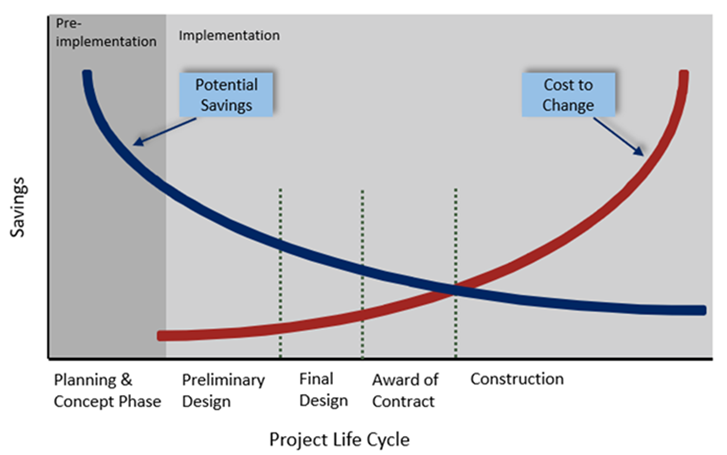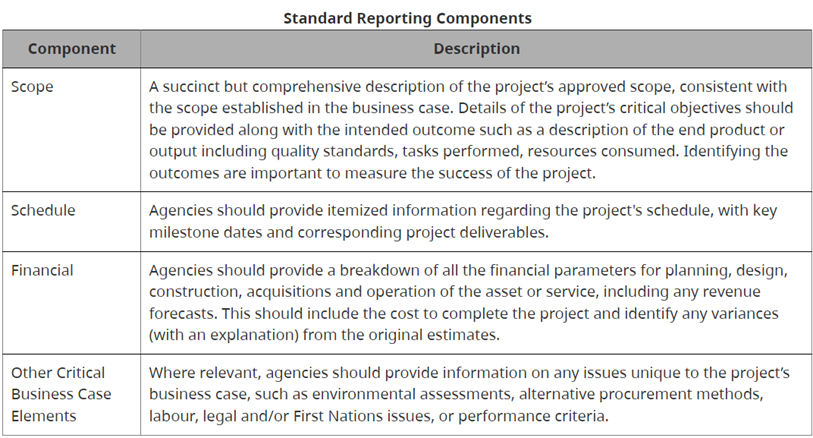COMPREHENSIVE REPORTING FOR PUBLICLY FUNDED INFRASTRUCUTURE PROJECTS (2023)
Issue
The purpose of this resolution is to improve transparent infrastructure project cost reporting and monitoring, to ensure accountability and effective risk and cost management of publicly funded infrastructure projects.
Once a publicly funded infrastructure project's business case is completed, its budget is approved, and a public announcement regarding that project is made, governments need to publicly report the cumulative costs of the project, consistent with the project's purpose and need statement.[1]
If a future government decides to make changes to the project, they should be required to include all historical costs of any previously approved project scope statement[2], design choice, or location selected to undertake the issue the project is addressing in their public reporting, in a clearly accessible and transparent manner, while still ensuring the project continues to meet its original purpose and need.
Background
Two notable examples of the importance related to reporting of all previous infrastructure projects costs include the Site C Dam and the George Massey Tunnel Replacement Project. Both projects were announced, and construction begun under previous governments. When the current government formed, these projects were reassessed with differing decisions on the preferred solutions, and/or with cost overruns.
Site C Dam Project
With BC Hydro’s Site C Dam Project, announced in 2010[3], the original budget in the 2014 business case was anticipated to be a project capital cost of $8.335 billion[4], however when a new government was formed in 2017, “the Premier commissioned an extensive review of the project, as mentioned above, that resulted in the Provincial Government approving the continuation of the project in December 2017.”[5] The updated Site C Project budget was then established at $10.7 billion, however due to geotechnical issues, COVID-19, and other challenges, in 2021 it was announced that the project would result in a nearly $16 billion price tag and take an additional year to complete, while the alternative of cancelling it would result in “$10.2 billion in sunk costs, contract termination and environmental remediation”[6]alone.
In this example, while the current government did not begin the Project, reporting for the comprehensive costs of the Project are being reported.
George Massey Tunnel Replacement Project
The George Massey Tunnel was originally built in 1959 and a replacement crossing, in the form of a 10-lane toll bridge, was announced by the previous government in 2013 with an approved business case and budget of $3.5 billion and an estimated completion date in 2022.[7] When the new government was formed in 2017, this project was cancelled. The new George Massey Tunnel (aka George Massey Crossing) Project business case includes an approved budget of $4.15 billion[8] for a toll-free 8-lane immersed tube tunnel, in lieu of a tolled 10-lane bridge.
The current project website “Highway 99 Tunnel Program” lists documentation and reflects associated costs only from 2019 onward. None of the documentation for the previous work completed on the project, nor reporting on the funds expended by Province on the replacement of the George Massey Tunnel (under the current or previous title of the project) are included in the current reporting on total costs for the project.
The cancellation of the initial replacement project resulted in $70 million[9] in “engineering and geotechnical work, public consultation, land procurement and site clearing, including preparations for eventual widening of Highway 99” and compensation for companies whose bids were cancelled with the project cancellation. There has been an additional $40 million[10] spent in upgrades to the current tunnel, which will be demolished and removed at completion of the project, which is estimated for to be in 2030.
In this example, while the current government did not begin the project, only the “new” iteration of costs are being reported in the Project Business Case.[11] Additionally, during the 2020 provincial election, the previous government promised that if they were re-elected, they would cancel the new tunnel project and revert back to a bridge project[12], which would again incur further costs towards the cumulative project total.
According to the B.C. Government’s Capital Asset Management Framework Guidelines, “project design is a complex process that often requires agencies to make trade-offs between functional elements, building materials, design elements and aesthetics in order to stay within their budgets[13]” and “alternatives are identified and evaluated from the perspectives of cost, reliability, performance and other requirements, and the agency chooses the options that offer the best value for money[14].” As shown in their accompanying diagram (Figure 1) below, once contracts are awarded and construction on a project has begun, the cost to change a project outweighs the potential savings of making that change.

Figure 1 – Project Value Analysis
The same Guidelines do go on to explain that government agencies are “free to carry out their capital mandates with minimum intervention from the Province with flexible guidelines to encourage innovation and to accommodate differences in agencies, projects and the factors driving service delivery needs” however they note that “at the same time, agencies must be fully accountable for managing capital assets effectively” and that “reporting and monitoring are essential to accountability as well as to effective risk and cost management.”
While recognizing the authority and value of government to manage their portfolios and projects in a manner which reflects their values and ethos; and understanding that this may at times mean changing course or cancelling a project already in motion, cumulative reporting for a project provides a truly comprehensive understanding of the costs associated with that project.
This reporting should be done related to the full project scope[15] (i.e., seismic upgrade of a school, build a hospital, replace a tunnel, etc.) as outlined in its purpose and needs statement, and focus on the issue being addressed or problem being solved by the problem, rather than the design-specific solution selected by the government of the day (i.e., replacing tunnel vs “George Massey Tunnel Project” or “Fraser River Tunnel Project”). This transparent and comprehensive manner of reporting provides the opportunity for better decision-making, improved public trust, and more efficient use of public funds.

Figure 2 - Project Reporting Components: Capital Asset Management Framework Guidelines[16]
THE CHAMBER RECOMMENDS
That the Provincial Government:
- Report in a transparent way the cumulative costs, including all historical costs of work undertaken for previously approved project scope statements, design choices, or alternative locations, as part of the total costs to complete an infrastructure project.
[1] https://dot.ca.gov/programs/environmental-analysis/environmental-management/purpose-need/purpose-need-why-who-when
[3] https://www.BChydro.com/news/press_centre/news_releases/2010/province_announces_site_c_clean_energy_project.html
[5] https://www2.gov.BC.ca/assets/gov/farming-natural-resources-and-industry/electricity-alternative-energy/electricity/milburn_summary_review.pdf (pg 6)
[8] https://www.highway99tunnel.ca/app/uploads/sites/748/2022/03/gmc-business-case-redacted.pdf (pg 65)
[9] https://vancouversun.com/news/politics/ndp-cancels-construction-on-george-massey-bridge-project/
[13] https://www2.gov.BC.ca/gov/content/governments/policies-for-government/capital-asset-management-framework-guidelines/budget-and-cost-management#9.2
[14] Ibid
[15] https://www2.gov.BC.ca/gov/content/governments/policies-for-government/capital-asset-management-framework-guidelines/reporting-and-monitoring
[16] Ibid
